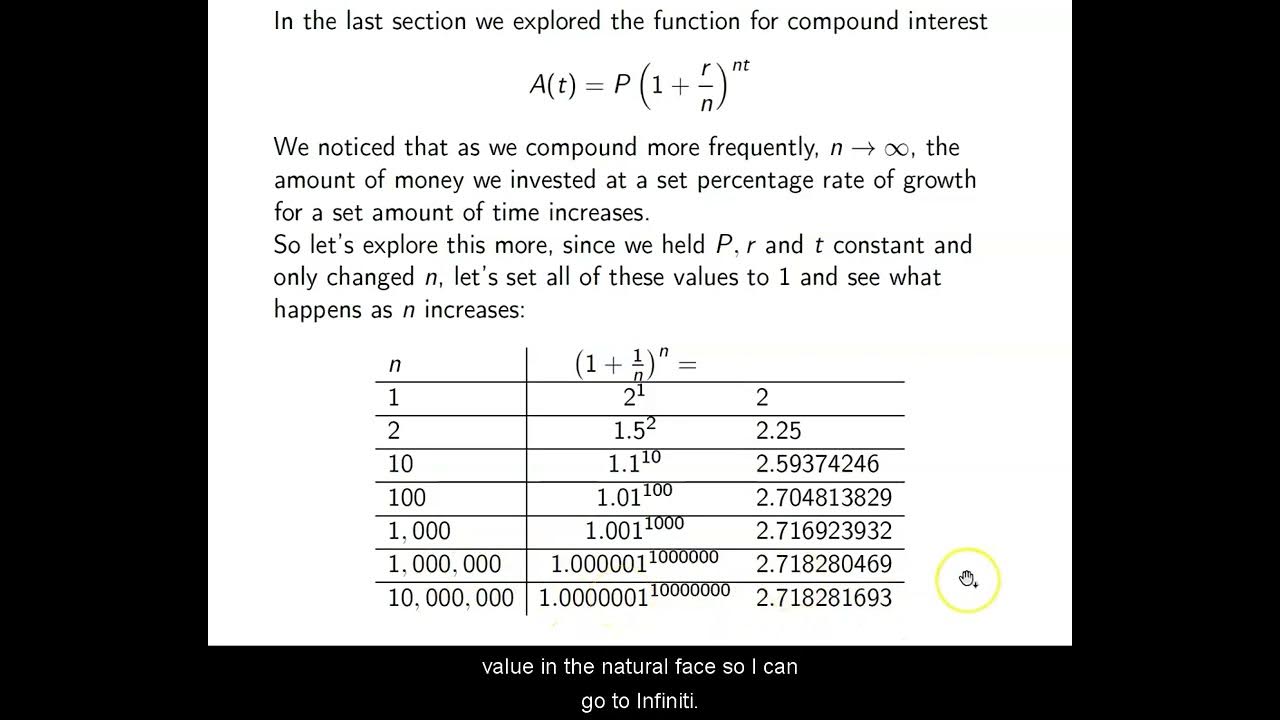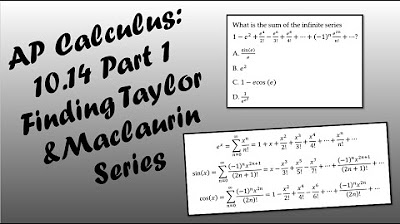Approximating functions with polynomials (part 3)
TLDRThe video script discusses the use of Maclaurin series, a polynomial approximation for the exponential function e^x. It explains that the derivatives of e^x evaluated at 0 are all 1, leading to a simplification of the series as a sum of terms x^n/n!. The script highlights the beauty of representing the complex number e as an infinite polynomial series, emphasizing the elegance and simplicity of this representation. It also introduces an alternative definition of e as the sum of 1/n! from n=0 to infinity, showcasing the number's significance in mathematics and its emergence from various mathematical contexts like compound interest.
Takeaways
- 📌 The concept of using Taylor series, specifically Maclaurin series approximation, is introduced to approximate functions like e^x with polynomials.
- 🔍 The Maclaurin series is defined as the sum from n=0 to infinity of the nth derivative of a function evaluated at 0, multiplied by x^n over n!.
- 🌟 A unique property of e^x is that all its derivatives at x=0 are 1, simplifying the Maclaurin series to 1 + x + x^2/2! + x^3/3! + ...
- 🧠 The idea that the rate of change of e^x with respect to x, at x=0, is 1, and this rate of change remains constant for all derivatives, highlighting the unique nature of e^x.
- 📈 The Maclaurin series not only approximates e^x at x=0 but also converges to e^x for all x, showcasing the power of infinite series in capturing the essence of functions.
- 🤯 The number e can be represented as the sum from n=0 to infinity of 1/n!, providing a new perspective on this mathematical constant beyond its relation to compound interest.
- 🌐 The script emphasizes the beauty and simplicity found in the representation of complex mathematical concepts through series and polynomials.
- 💡 The example of e^x illustrates how a seemingly complex number can be expressed as a simple, infinitely extending polynomial series, revealing an underlying order within chaos.
- 📚 The script encourages pondering and appreciating the mysterious and profound nature of mathematical constants like e, and their applications in various fields.
- 🚀 The video promises to explore more functions and their Maclaurin series in future content, hinting at further insights into the interconnectedness of mathematics.
- ✨ The script concludes with a sense of excitement and awe at the possibility of uncovering even more mind-blowing mathematical concepts and series in upcoming lessons.
Q & A
What is the main topic discussed in the transcript?
-The main topic discussed in the transcript is the use of Taylor series, specifically the Maclaurin series approximation, to approximate the exponential function e^x with a polynomial.
What is the definition of the Maclaurin series as mentioned in the transcript?
-The Maclaurin series is defined as the sum from n equals 0 to infinity of the nth derivative of a function f evaluated at 0, times x to the power of n, divided by n factorial.
What is special about the derivatives of the function f(x) = e^x?
-The special thing about the derivatives of f(x) = e^x is that every derivative at any point, including at x=0, is equal to e^x itself. This means that the rate of change of y with respect to x is always 1, and all higher order derivatives also equal 1.
How does the Maclaurin series for e^x simplify?
-The Maclaurin series for e^x simplifies to the sum from n equals 0 to infinity of x to the power of n, divided by n factorial, with every coefficient being 1 due to the properties of e^x and its derivatives.
What does the infinite Maclaurin series converge to for e^x?
-The infinite Maclaurin series for e^x converges to the actual function e^x at all points. This means that the sum of the series is equal to e^x for any value of x.
What is the significance of the number e when x equals 1 in the Maclaurin series?
-When x equals 1 in the Maclaurin series, the sum simplifies to e, which is the value of the mathematical constant e. This provides another definition of e as the sum from n equals 0 to infinity of 1 over n factorial.
What is the author's reaction to the Maclaurin series approximation for e^x?
-The author finds the Maclaurin series approximation for e^x to be amazing and beautiful, as it reveals a simple and patterned polynomial series that approximates the complex number e.
How does the Maclaurin series relate to the concept of compound interest?
-The Maclaurin series for e^x is related to compound interest because the number e is derived from the mathematical formula for continuously compounding interest, where the limit of (1 + 1/n)^n as n approaches infinity equals e.
What other functions does the author mention will be discussed in the future?
-The author mentions that more functions will be discussed in the future using the Maclaurin series, hinting at further insights and potentially mind-blowing revelations about these functions.
What is the author's overall impression of the number e?
-The author views the number e as mysterious and fascinating, with its appearance in various mathematical contexts such as compound interest and its ability to be expressed as a simple infinite series.
Outlines
📚 Introduction to Maclaurin Series and e^x
This paragraph introduces the concept of the Maclaurin series, a specific case of the Taylor series, to approximate the exponential function e^x. The speaker explains that the Maclaurin series is the sum of derivatives of a function f(x) evaluated at x=0, multiplied by x raised to the power of n and divided by n!. The speaker then focuses on the unique properties of e^x, highlighting that all its derivatives are equal to itself and that the series simplifies to a sum of terms with 1 as the coefficient for each power of x. The speaker emphasizes the beauty and simplicity of expressing e^x as an infinite polynomial series, which reveals a deeper understanding of the mathematical constant e.
🤯 The Number e and its Amazing Properties
In this paragraph, the speaker delves deeper into the properties of the mathematical constant e, demonstrating how it can be expressed as the sum of the series 1/n! from n=0 to infinity. The speaker expresses amazement at the simplicity and elegance of this representation and compares it to other definitions of e, such as the limit of (1 + 1/n)^n as n approaches infinity, which is related to compound interest. The speaker's enthusiasm for the number e is palpable as they explore its significance and the profound insights it offers into the nature of mathematical patterns and series.
Mindmap
Keywords
💡Taylor series
💡Maclaurin series
💡e to the x (e^x)
💡Derivative
💡Polynomial
💡Infinite sum
💡Factorial
💡Approximation
💡Slope
💡Compound interest
💡Rhythm
Highlights
The speaker had dinner before recording the video, which may have affected their memory of the previous content.
The speaker intends to use the Taylor series, specifically the Maclaurin series approximation, to approximate e to the power of x with a polynomial.
The Maclaurin series is defined as the sum from n equals 0 to infinity of the nth derivative of a function evaluated at 0 times x to the power of n over n factorial.
For the function e to the x, the value of the function at 0 is 1, and all its derivatives at 0 are also 1.
The rate of change of y with respect to x for e to the x is 1, indicating that the slope of the function at x equals 0 is 1.
The Maclaurin series for e to the x simplifies to the sum from n equals 0 to infinity of x to the power of n over n factorial, with all the coefficients being 1.
The infinite Maclaurin series for e to the x not only approximates the function at x equals 0 but also equals e to the x for all x.
The Maclaurin series at 0 can converge to the function at all points, which is the case with e to the x.
The speaker expresses a sense of wonder at the mathematical beauty of the Maclaurin series for e to the x.
The number e, which is approximately 2.7, can be written as an infinite polynomial series or Maclaurin series, which the speaker finds fascinating.
When x equals 1 in the Maclaurin series for e to the x, the series simplifies to the sum from n equals 0 to infinity of 1 over n factorial, which is another definition of e.
The speaker is amazed by the fact that summing up 1 over n factorial for all integers from 0 to infinity results in the number e.
The speaker plans to discuss the Maclaurin series for more functions in the next video, hinting at more exciting content to come.
The speaker emphasizes the importance of pondering the number e, highlighting its mysterious and intriguing nature.
The speaker notes the unique property of e to the x where all derivatives at 0 have a value of 1, contributing to the understanding of the function's behavior.
The speaker provides a step-by-step breakdown of how the Maclaurin series for e to the x is derived, offering clarity and insight into the process.
The speaker reflects on the simplicity and elegance of expressing complex numbers like e as infinite series, which reveals a deeper understanding of mathematical concepts.
The speaker's enthusiasm for the mathematical properties of e and its applications, such as in compound interest, is evident throughout the discussion.
Transcripts
Browse More Related Video

Ch. 4.2 The Natural Exponential Function

Worked example: estimating e_ using Lagrange error bound | AP Calculus BC | Khan Academy

Polynomial approximation of functions (part 2)

Radius of convergence using Ratio Test

AP Calculus BC Lesson 10.14 Part 1

The Definite Integral Part III: Evaluating From The Definition
5.0 / 5 (0 votes)
Thanks for rating: